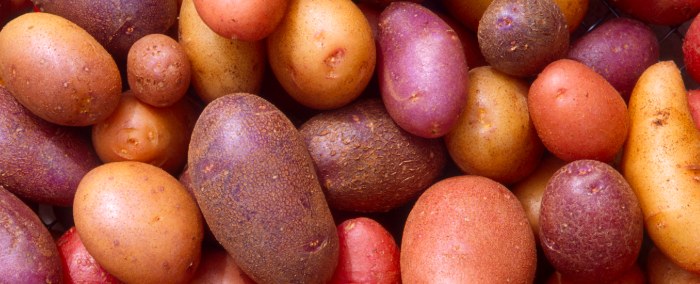
Scientists and the media often mention the general reduction of biodiversity. But is this valid for all species, and especially for a species as important for human consumption as potatoes?
In Europe, since the 16th century …
The potato arrives in Europe, in the middle of the 16th century, in the boats of the conquistadores returning from Peru. It is gradually spread throughout the continent by soldiers, monks, scientists and agronomists. As its geographical dispersion and its cultivation by man, we find more and more different potatoes. From the nineteenth century, the potato has taken a large place in the diet of men, the selection work becomes intense. And so today there are about 1,180 varieties of potatoes listed in theEuropean catalog of species and varieties.
Varieties and cultivated biodiversity
In a broad sense, biodiversity concerns all forms of life. It covers both the diversity of ecosystems and that of species . It is also manifested within the same species, by the genetic differences that distinguish individuals, some of which can be grouped into ” varieties ” in the case of cultivated plants. Thus, the plants of the same potato variety have common characteristics in terms of their shape, their color, their biological faculties (such as resistance to this or that disease), or their culinary qualities. . Because of the importance of the potato across the planet,select new varieties, adapted to specific needs related to climate, soil conditions, dietary habits etc. And each new variety of potato comes to enrich the cultivated biodiversity!
Genetic resources to preserve
The different types of potato-related plants, be they representatives of wild ancestors and ancient populations, or of contemporary varieties , are the genetic resources of the potato. These resources are part of the heritage of humanity, which makes their conservation quite essential. To create new varieties, breederscross between them plants with different genetic heritages. The greater the diversity of usable plants, the greater the scope for obtaining potatoes that can meet the needs of today and tomorrow. The interest of the conservation of genetic resources again appears clearly. However, the management of genetic resources requires multiple skills and rigorous monitoring. Networks of scientists collect them, study them, describe them and make them last in the form of seeds or plantswell alive. They conserve all sources of biodiversity around the world. Among these scientists, breeders, in addition to their own collections, participate in these national and international networks.
Keep safe
In France, in the station of the National Agricultural Research Institute of Ploudaniel (Finistère), more than 6,000 plants constitute the largest national collection for potatoes. Naturally, all these plants must remain able to be multiplied and cultivated. The conservation of genetic resources is often done by cultivation in the fields. Fragile plants that are poorly adapted to our seasons are protected in the greenhouse during the winter. For safety, tubers are kept in containers or in vitro culture . New techniques are emerging such as storage in liquid nitrogen. Finally, it is also possible to keep varietiespotato in the form of seeds. Thus, by using different methods of conservation, in France as elsewhere in the world, the researchers put all the chances on their side so that samples of all the types of potato registered until today are preserved for the future generations.
Varieties of potatoes: a diversity that gets richer
In 1567, a variety of red potato with purple flowers was imported to Antwerp from South America via Las Palmas. At the end of the 16th century, a yellowish potato with white or purple flowers arrives from North America on an English boat. Although it is difficult to obtain precise information on the varieties available in Europe over time, several clues allow us to follow the path of an impressive progression, thanks in particular to the permanent work of the breeders :
- 1730: Irish texts report the existence of 5 varieties of potato;
- 1777: the famous encyclopedia of Diderot and Alembert describes 40 ;
- 1810: there are 110 varieties of potatoes;
- 1846: the catalog of Henri de Vilmorin counts 177 ;
- nowadays: 1,180 varieties are registered in the European catalog.
A global network to conserve genetic resources
Since potatoes are grown all over the world, an international network organization has been set up to conserve the genetic resources specific to this tuber. The breeders participate in it and can also buy it for their research work.
Among the members of this organization are: the International Potato Center in Peru, the Wageningen Center in the Netherlands, the Surgeon Bay Center in the United States, the Vavilov Institute in Russia and the INRA Station in Ploudaniel (Finistère) for France.
Food security, a priority of the CIP
The International Potato Center (IPC) was established in Lima, Peru in 1971. It is the largest scientific research center in the world for tubers and food roots: sweet potato, potato … It is an association that aims to reduce poverty, develop food security in developing countries, and now anticipate climate change.
The CIP holds a gene bank of more than 5,000 varieties of wild and cultivated potatoes. In the event of disasters (floods, earthquakes …), the IPC can send seedlings of destroyed varieties to devastated areas to start new crops.
The CIP also produces potato varieties genetically modified for their resistance to diseases, pesticides or climatic accidents: drought, flooding.
Nice article, i like it!